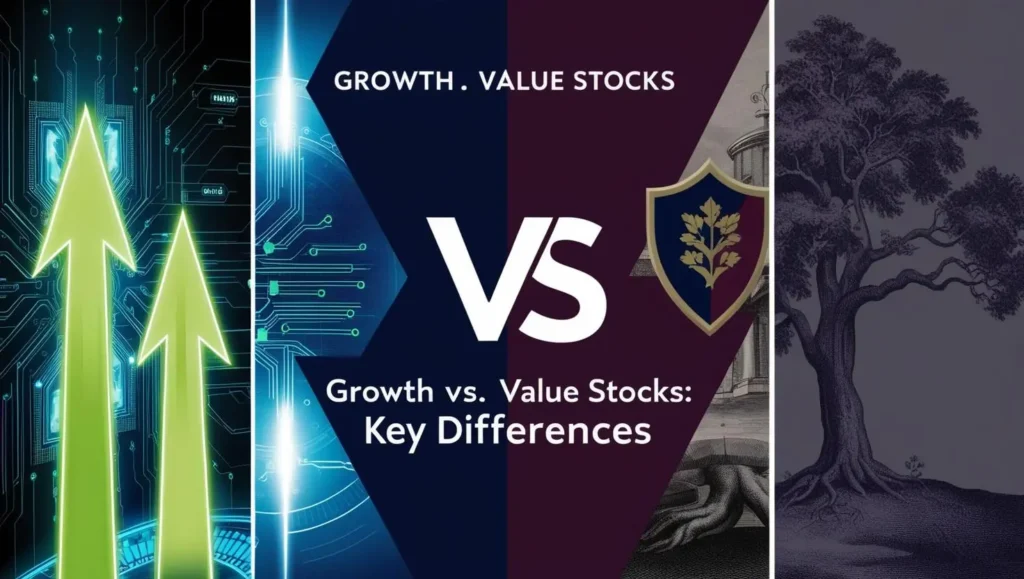1. Introduction: What Are Growth & Value Stocks?
Understanding the difference between growth and value stocks is crucial for any investor in 2025. These two distinct investment strategies represent different approaches to building wealth in the stock market. Growth stocks focus on companies with high potential for future expansion, while value stocks target undervalued companies with strong fundamentals. As we explore the key differences between growth and value stocks, you’ll gain valuable insights to help shape your investment strategy.
As we delve into the world of growth and value stocks, it’s important to remember that these aren’t the only strategies available to investors. Some investors prefer a more stable approach, focusing on consistent income through dividend-paying stocks. For those interested in this strategy, our article on Dividend Aristocrats Investing: A Smart Strategy for Long-Term Wealth provides valuable insights into building a portfolio for steady, long-term returns.
2. Growth Stocks Explained: High Risk, High Reward?

Definition and Key Characteristics
Growth stocks, such as Tesla and Nvidia, are known for their high potential returns but also come with significant volatility. Investopedia provides a detailed explanation of growth stocks and their characteristics.
- High revenue and earnings growth
- Reinvestment of profits for expansion
- Market leaders in innovative sectors
- Higher valuation metrics (e.g., P/E ratios)
Examples of Growth Stocks
- Tesla (TSLA) – Electric vehicles and sustainable energy solutions
- Amazon (AMZN) – E-commerce and cloud computing leader
- Nvidia (NVDA) – Semiconductor and AI technology powerhouse
Pros & Cons of Growth Stocks
✅ Pros:
- Potential for significant capital appreciation
- Industry disruptors with competitive advantages
- Market dominance and scalability opportunities
❌ Cons:
- High volatility and market sensitivity
- Expensive valuation (high P/E ratios)
- Vulnerability to economic downturns
3. Value Stocks Explained: Stability and Undervaluation
Definition and Key Characteristics
Value stocks are shares of companies that trade below their intrinsic value. These firms often have a long-established presence, generate steady profits, and pay dividends to investors.
- Lower valuation ratios (e.g., P/E, P/B ratios)
- Consistent earnings and dividends
- Stable financials with strong fundamentals
- Lower market volatility compared to growth stocks
Examples of Value Stocks
- Coca-Cola (KO) – Global leader in beverage industry
- Johnson & Johnson (JNJ) – Healthcare and pharmaceutical giant
- Berkshire Hathaway (BRK.B) – Warren Buffett’s diversified conglomerate
Pros & Cons of Value Stocks
✅ Pros:
- Stability and lower market fluctuations
- Consistent dividend payments
- Ideal for long-term conservative investors
❌ Cons:
- Slower growth compared to growth stocks
- Limited upside potential during bull markets
4. Key Differences Between Growth and Value Stocks
Comparison of Performance in Different Market Conditions
The primary differences between growth and value stocks lie in their risk-reward profiles and market conditions. Fidelity Investments provides a comprehensive comparison of these two investment styles in their educational resources.”
- Growth stocks outperform in bull markets when economic conditions are strong.
- Value stocks tend to do better in bear markets, offering resilience during downturns.
Risk vs. Reward Profile
| Feature | Growth Stocks | Value Stocks |
|---|---|---|
| Risk Level | High | Low to Moderate |
| Return Potential | High | Moderate |
| Market Sensitivity | Highly reactive | Less reactive |
| Dividend Payouts | Rarely paid | Frequently paid |
Ideal Investor Profiles
- Growth investors: Risk-tolerant individuals seeking high returns.
- Value investors: Conservative investors looking for stability and income.
5. Growth vs. Value: Which Strategy Works Best in 2025?
As we enter 2025, several factors will shape the performance of growth and value stocks:
- Inflation & Interest Rates: Rising interest rates generally impact growth stocks negatively, while value stocks benefit from a stronger economic foundation.
- Technology Advancements: AI, automation, and green energy sectors could continue driving growth stocks forward.
- Global Economic Trends: Investors should consider macroeconomic factors, geopolitical risks, and fiscal policies when selecting their investment strategy.
Historical Performance Trends
Historically, value stocks have outperformed growth stocks during market recoveries and high-interest-rate environments, while growth stocks shine during times of economic expansion and low rates.
6. How to Build a Balanced Portfolio with Growth & Value Stocks
The Importance of Diversification
A well-balanced portfolio reduces risk and maximizes returns by combining both growth and value stocks.
Strategies for Effective Diversification
- 50/50 Growth & Value Allocation: Balanced exposure to both strategies.
- Sector Rotation Strategy: Adjusting investments based on economic cycles.
- Using ETFs to Gain Exposure:
- Vanguard Growth ETF (VUG) – Focuses on high-growth stocks.
- Vanguard Value ETF (VTV) – Provides exposure to stable, undervalued companies.
7. Conclusion & Investment Tips
While understanding the differences between growth and value stocks is crucial, it’s equally important to stay informed about the platforms you use for investing. The landscape of online brokerages is constantly evolving, with some platforms gaining popularity among younger investors. For an in-depth look at one such platform, check out our analysis of Robinhood Stock: A Rollercoaster Ride in 2025. This article provides valuable context on how changing market dynamics and investor preferences are shaping the future of stock trading.
Final Investment Tips
- Assess your risk tolerance before committing to a specific strategy.
- Stay updated on market trends, interest rates, and economic indicators.
- Use ETFs to simplify diversification between growth and value stocks.
- Regularly review and adjust your portfolio to maintain optimal balance.
By understanding the key differences between growth and value stocks, investors can make informed decisions and build a portfolio that aligns with their financial goals in 2025 and beyond.


[…] investors navigating Tesla’s volatility, understanding broader market trends is essential. Growth and value stocks each present unique opportunities, and knowing the difference can shape a smarter investment […]